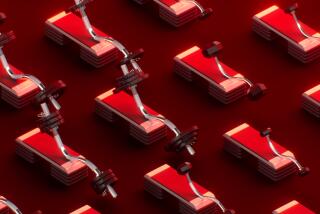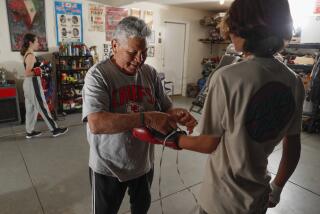Still Standing at the Bell : Despite a Debilitating Stroke, Boxing Promoter Frankie Goodman, 74, Continues to Operate the Memory-Filled Van Nuys Gym He Opened in 1973
Frankie Goodman, 74, walks a mile to his Van Nuys gym every day. He sits down on the apron of the blue-canvas boxing ring, crosses his legs and lights a cigar. Leaning back, he looks through thick glasses and watches young men throw punches at leather heavy bags. Little more than a year ago, he would have been beside them sharing his half-century of wisdom in the sweet science, but now, he just watches, lulled by the gym’s staccato rhythms, cigar smoke curling to the ceiling.
In the world of boxing, Goodman has been just about everything--fighter, promoter, TV host, amateur-boxing booster, Olympic boycotter, sports columnist, trainer--but a stroke in February 1988 has slowed his once-frantic pace to a crawl. “He’d usually be working with the boys or making matches--on the phone talking to some boxing big shot,” says trainer Les Gesno, a friend of 45 years. “The stroke hit him pretty hard.”
Although Goodman has come back physically--he can still get into the fighter’s classic crouch and rip an uppercut--he has difficulty communicating. “Mr. Goodman is definitely improving,” says Steven Todd, a 46-year-old mirror-maker who has helped keep the gym open during Goodman’s recovery. “But his return to normalcy doesn’t seem imminent.”
Goodman, a widower known for his dapper dress--white suits with open-neck shirts and an ever-present cigar--still looks out of place at the gym in a white sweater, wool pants and shiny black loafers. Friends and fighters show up regularly at his side and keep him company. Treating him with reverence without being patronizing, they have mastered the ability to hold conversations even though Goodman often speaks a language they cannot understand.
A becalmed presence amid the swirling activity, Goodman looks around the gym’s walls, papered with photos and articles. “Memories,” someone says to him. “Memories,” he says, nodding. Then he gets up and walks to a poster of a once-promising heavyweight named OK Myles, at one time a protege. “Waiting, waiting, and it didn’t come,” Goodman says, shaking his head sadly over unfulfilled potential.
Todd takes a visitor down memory lane, pointing out that “Mr. Goodman specialized in kids. Just look at these pictures.” There was Goodman, his torso poking out a hole in the canvas, teaching a youngster the manly art. There was Goodman, refereeing a bout between a pair of 7-year-old “peanutweights” on a 1950s TV program called “Kid Gloves.”
It was Goodman who started Jerry Quarry, Bobby Chacon and Mando Ramos on the road to boxing success. Hundreds of others learned at his gym. Of his involvement with pint-sized fighters, Goodman once said: “I take kids who are crybabies, who don’t know how to defend themselves, and I give them confidence. It’s probably the single most rewarding aspect of the fight business.”
Memories. Goodman calls over a visitor and points to old photos of himself and the fight crowd. Muhammad Ali when he was Cassius Clay. Don King with normal hair. Then he puts a forefinger on a photo of the Penn State boxing team, circa mid-30s. Seeing himself, chest puffed out in a tight letter sweater, he shakes his head and raises a sardonic eyebrow. The memory was not a good one.
Goodman, intercollegiate lightweight champion at Penn State, was a strong candidate for the 1936 U. S. Olympic boxing team. The Olympics were to be held in Berlin and were expected to be a propaganda tool for Hitler. After he won his semifinal bout at the Olympic Trials, Goodman, who was raised by Orthodox Jewish parents, was persuaded by a Jewish group to withdraw and boycott the Berlin games.
“It was every athlete’s dream to go to the Olympics,” he once said. Years after his boycott, he felt that he had been used, that making a statement with his fists would have sent a louder message to Hitler. Even his induction into the Jewish Sports Hall of Fame didn’t take away his bitterness, friends say.
After serving in the Navy in World War II--there’s a photo in the gym of Goodman and his class graduating from boot camp--he began producing his “Kid Gloves” TV show in his hometown of Philadelphia. CBS picked it up and broadcast in nationally. When Goodman moved to Los Angeles in the late 1950s, the shows were aired locally on KHJ-TV. Goodman also wrote a book titled “How to Teach a Boy to Box” and a weekly column in the old Valley News & Greensheet called “Boxing Biz.” He and Joe Louis promoted fights at the Sports Arena.
On a wall at the gym, a brittle page from Boxing Illustrated summarizes Goodman’s place in the sport’s pantheon: “Boxing Needs a New Federal Commissioner--Me.” The article, written by Goodman, went on to state: “I have done more in all phases of boxing than any other man in the world.” A 1983 story in The Times referred to the article and said: “It’s impossible to dismiss it simply as self-serving public relations. In boxing, Frankie Goodman has literally done it all.”
In 1973, Goodman opened “Goodman’s Gym--Kid Gloves Boxing School” on the second floor of a deserted Van Nuys Boulevard storefront. The gym had immediate character and got even more disreputable over time. Today, duct tape holds heavy bags and carpeting together, springs protrude from couches, paint is chipped from lockers, and sunlight fights through layers of grit on smoked-glass windows.
Never a moneymaker, the gym was a sanctuary to Goodman, who subsidizes it today with his Social Security income. Todd, Gesno and two or three other regulars keep the gym going, showing up to open doors at 4 p.m. and close them at 7 and train fighters in between. Goodman is there, too, watching, surrounded by memories and caring friends. At 7, Gesno drives him home.
A few years ago, Goodman told a reporter, “I’ve tried to get out of the game lots of times, but boxing just keeps dragging me back. You know, somebody calls me for advice. Or I’ll see a new kid with lots of potential. It’s always something. Aw, what the hell, I might as well admit it. Boxing, I guess it’s just in my blood.”
More to Read
Go beyond the scoreboard
Get the latest on L.A.'s teams in the daily Sports Report newsletter.
You may occasionally receive promotional content from the Los Angeles Times.










